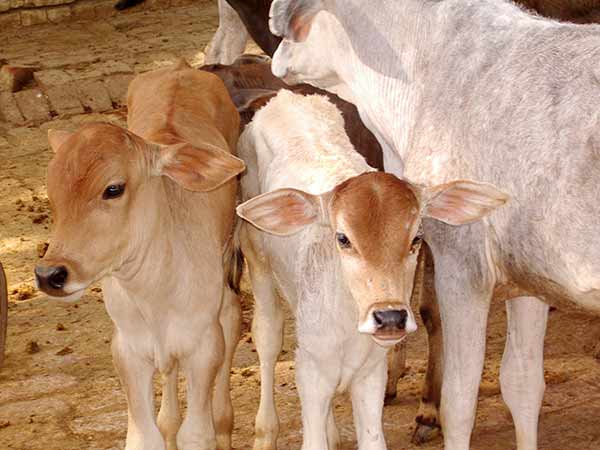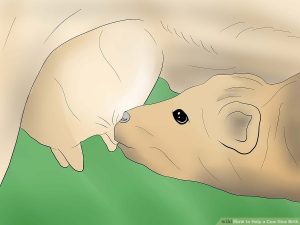
Common Protocols in Management of Diseases in Newborn Calves
Newborn Calf Management
The future of dairy herd depends upon how calves are raised. The newborn calves of today are the milking cows of tomorrow. The calf is the starting point for building up a good dairy herd. In Animal husbandry practice, It is always said by many experts that “Good animals are to be raised and not purchased”. Ideally one has to raise own calves to make good herd. Improper management and unhygienic conditions in the farm may cause infections and diseases to the newborn calves. Hence calf rearing should be taken upon scientific lines and need to be economically achieved. The present article discusses the common newborn calf diseases and preventive measures to be taken for controlling them.

Calves usually suffer from various diseases in the first six months of their life span. Lack of Colostrum Immunity continues to be a major predisposing factor for newborn calf diseases and economic loss in dairy farming. Newborn calves are not born with a completely developed host defense mechanism, hence they are prone to many diseases. Research workers noted that the majority of illness and death of calves in the first three months of life is due to insufficient feeding colostrum to calves after birth, hence colostral protection plays important role in the early period of calf life.
Feeding Colostrum to Calves
Colostrum is the first milk of a dam that gets available immediately after parturition. Hence it is called as a first feed for the newborn. It contains antibodies that confer passive immunity to protect the newborn from many diseases during the early period of life span.
- The optimum time for feeding colostrum: colostrum should be fed within 2 hrs after birth because during that period more concentration of antibodies is present in colostrum which gets rapidly absorbed from calf intestine.
- Rate of colostrum feeding: It should be fed 10% of calf body weight, usually about 2.5kg of colostrum is sufficient for a newborn calf.
- Frequency of colostrum feeding: It should be divided into 2-3 doses to avoid digestive complications.
- Period of colostrums feeding: It should be given for at least 3 to7 days after birth. Ideally, a calf should get 2-2.5 lit daily for the first 3 days.
Importance of colostrum feeding
- Colostrum contains antibodies named gamma globulin which provides passive immunity to calf against various diseases.
- It has a laxative action and helps to evacuate meconium results in proper defecation after birth.
- The protein content of colostrum is 3-5 times higher than normal milk.
- Colostrum supplies Vitamin A, B2, choline, thiamine and also minerals like calcium, phosphorus, copper, iron, magnesium, etc.
- Colostrum provides immunoglobulin which is getting absorbed from the small intestine and provides passive immunity against systemic diseases. Immunoglobulin in colostrum neutralizes pathogenic bacteria present in the gut.
Important Common diseases of calves
Calf scour/ Colibacillosis
An important disease in dairy calves causing the highest rates of mortality
Causes: Bacterial-E.Coli, Viral-Rota virus, Corona Virus, and predisposing factors like insufficient feeding of colostrum, poor farm hygiene
Symptoms: Inappetance, weakness, dehydration, fever, passing of loose feces with an unpleasant odour. feces are characterized by colour varying from yellowish-brown, white and occasionally blood-stained. A peculiar fetid odour comes from feces.
Management: Provide sufficient colostrum feeding to the newborn calf. Vaccination for calf scours. Affected animals to be treated with fluid therapy, specific antibiotics and supportive treatment by a veterinary practitioner. Maintain a good hygienic environment in the farm
Navel ill (Omphalitis/ Omphaloplebitis)
Causes: Mixed infection of Staphylococcus, E. coli, Proteus, etc.
Symptoms: Affected calf usually shows painful swelling at the site of the umbilicus, drainage of pus and purulent material, high rise in temperature and reduced appetite. Calf suffered appears weak, dull and depressed.
Management: Naval/Umbilical Cord It is the connection of the fetus with the mother when it remains in mother’s womb. It consists of amniotic membrane, umbilical veins and umbilical arteries. This naval cord is torn after birth and normally umbilical cord dries up within a week after birth. Infection of umbilical cord occurs soon after birth and may result in inflammation of umbilicus (omphalitis), umbilical veins (omphalophlebitis) and arteries (omphaloarteritis). should be tied up with cotton thread after birth and dip the navel cord in 5% povidone-iodine solution after birth to control the contamination.
Joint ill (Septic arthritis)
Causes: Extension/ complications after Naval cord infection. Sometimes if the naval ill does not get treated, the infection may spread via the bloodstream and settle in other parts of the body. The commonest site for bacteria to settle in the joints.
Symptoms: Affected calf shows painful swelling at joint and symptoms like high fever, anorexia, depression, and discharge may come from joints.
Management: Early and prompt care will be beneficial. Antibiotics and painkillers are effective. Maintain a clean and hygienic environment, avoid naval cord infection by applying tincture iodine on naval flap after birth, optimum colostrum feeding.
Worm Infestation (Internal Parasitic Load)
Causes: Roundworm, Hookworm, and Tapeworm
Symptoms: Affected calf show clinical signs like diarrhea, rough hair coat, anemia, pot belly appearance of the abdomen.
Management: Broad-spectrum dewormers as per scheduled dose. Regular periodical deworming of the calf is recommended.
Calf Septicemia : The disease is characterized by presence of toxin produced by bacteria in blood. Septicemia occurs as a result of bacterial infection. The Route of infection is through the infected placenta, umbilical infection. The affected calf appears dull, depressed, weakness, reluctant to stand, in sever toxemic condition, suckling problem. Most septicemic calves have a history of insufficient colostrum feeding. (Presence of Toxins in the Blood)
Causes: Extension of umbilical infection, Organisms involved like E. coli and salmonella.
Symptoms: Affected calf appears dull, depressed, weakness, reluctant to stand, in sever toxemic condition, suckling problem.
Management: Provide sufficient colostrum feeding to the calf to develop passive immunity. Proper Management of Umbilical cord infection.
Calf pneumonia (Enzootic pneumonia): It is an infectious disease of newborn calves occurs at 2-5 months of age characterized by bronchopneumonia. The causes are Single or multiple entities are responsible for development. Common organisms involved are like Pasteurella multocida, Haemophilus sp, Mycoplasma bovis, actimycosis pyogenes, Salmonella sp., etc Affected calf show nasal discharge, dry cough, temperature 104-1050F, respiratory distress and decreased appetite. Treatment of the Provision of antibiotics, bronchodilators and antihistaminic may be beneficial. (Respiratory Disease)
Causes: Etiology is multifactorial-Viruses, Bacterial and Mycoplasma spp.
Symptoms: Affected calf show nasal discharge, dry cough, temperature 104-1050F, respiratory distress, and decreased appetite.
Management: Provide good ventilation to the calf. Finding out the specific cause and selecting management protocols. Administration of antibiotics, bronchodilators, and antihistaminic may be beneficial. Vaccination to be followed as preventive protocol.
Common protocols to be followed in the newborn calf management
The control of newborn calf diseases is the prime need to save the future of the dairy herd. The following are some of the common practices to be followed in order to control newborn calf diseases.
- Immediately after birth, remove the mucus from the calf’s nostrils that helps the calf to breath better
- Keep the calf with the mother after birth and allow the cow to lick the calf clean which promotes circulation in the calf’s body and prepares the calf to stand up and walk.

Licking and Cleaning of Calf - It is important to tie the navel cord with cotton thread and dip the navel with a 5% antiseptic povidone-iodine solution.

Important to tie the navel cord with cotton thread - Colostrum feeding: Colostrum is first feeding for the newborn. It contains antibodies that confer passive immunity to protect the newborn from many diseases during the early period of life span. The details of colostrum feeding and importance already discussed.

Newly born calves need to receive colostrum after birth - Deworming of calf needs to be done within 10-15 days and subsequently on a monthly basis up to 6 months to prevent the occurrence of worm infestations and to promote the health of the calf.
- Vaccination of the calf to be given above 3 months age through registered veterinarian practitioner in order to build up immunity against infectious disease by producing sufficient quantities of antibodies
- Calf starter may be provided from 2-8 weeks for better growth and early maturity.
Dr. Vijay Muley
Vetoquinol India Animal Health PVT Limited, Mumbai
